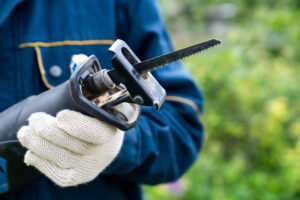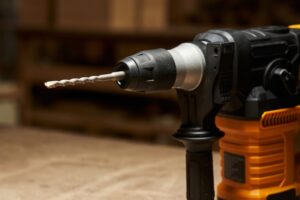A percussion drill, also known as an impact drill, is a power tool used for drilling in hard materials. It is a type of rotary drill with an impact mechanism that generates a hammering motion.

The percussive mechanism delivers rapid short hammer thrusts to pulverise the material being drilled, making drilling faster and requiring less effort. Percussion drills can also be used for tasks such as screwdriving.
Key Takeaways:
- A percussion drill, also known as an impact drill, is a power tool used for drilling in hard materials.
- The percussive mechanism of a percussion drill generates rapid short hammer thrusts, making drilling faster and easier.
- Percussion drills can be used for tasks such as screwdriving and chiselling.
- Percussion drills are versatile and essential power tools for various construction and DIY tasks.
- Proper safety measures should be followed when using percussion drills to prevent accidents or injuries.
How Does a Percussion Drill Work?
A percussion drill, also known as an impact drill, is a powerful tool that utilizes a unique mechanism to tackle drilling tasks in hard materials. Understanding how a percussion drill works can give us insights into its efficiency and effectiveness.
At the heart of a percussion drill is the cam-action or percussion hammering mechanism. This mechanism consists of two sets of toothed gears that interact with each other, generating a hammering motion while the drill bit rotates. The drill bit is held in place by the chuck, which is a specialised component that allows the drill bit to hammer and rotate simultaneously. The chuck moves forward and backward on the axis of rotation, enabling the rapid hammering action that characterises percussion drills.
The hammering action of the percussion drill is what sets it apart from regular drills. This rapid hammering motion delivers thousands of blows per minute, allowing the drill to pulverize hard materials like concrete and brick. The combination of the hammering action and the rotation of the drill bit results in efficient drilling through tough surfaces, making percussion drills the tool of choice for tasks that require drilling in challenging materials.
By harnessing the power of the hammer action, percussion drills excel in speed and effectiveness, providing users with a tool that can tackle demanding drilling tasks with ease. The versatility of percussion drills extends beyond drilling as they can also be used for tasks such as screwdriving when the hammer action is disabled. From DIY enthusiasts to construction professionals, percussion drills are essential tools that offer efficiency and convenience for a wide range of projects.
Uses of a Percussion Drill
When it comes to drilling in hard materials, a percussion drill, also known as an impact drill, is an essential power tool. Its hammering motion and rapid short hammer thrusts make drilling in materials like concrete and masonry faster and more efficient. But what are the specific uses of a percussion drill?
1. Drilling Holes for Anchor Bolts
In construction projects, the need to secure objects to hard surfaces like concrete often arises. This is where a percussion drill comes in handy. By using the drill with the appropriate drill bit, you can easily create holes for anchor bolts that will securely fasten items to the surface, providing stability and support.
2. Installing Concrete Screws
Concrete screws are commonly used for various construction and DIY projects. They require pre-drilled holes for proper installation. A percussion drill can effortlessly create these holes, allowing for the easy insertion and tightening of concrete screws, ensuring a strong and reliable connection.
3. Mounting Wall Plugs
Wall plugs, also known as anchors or rawlplugs, are essential for securely mounting items on walls. These plugs provide a strong base to hold screws and ensure stability. To install wall plugs, a percussion drill can quickly create the necessary holes, enabling you to securely fasten objects to the wall without worrying about them becoming loose or unstable.
Overall, percussion drills are versatile tools that excel in drilling holes in hard materials. Whether you need to install anchor bolts, concrete screws, or wall plugs, a percussion drill will simplify the process and provide reliable results. They are a go-to tool for construction projects and DIY enthusiasts alike, offering efficiency and convenience when it comes to construction drilling tasks.

Advantages of a Percussion Drill
When it comes to drilling, percussion drills offer significant advantages over regular drills. These power tools are designed to tackle hard materials such as concrete, brick, and thick lumber with ease. The key advantage of percussion drills lies in their drilling speed. They can drill through tough materials up to 30% faster than regular drills, saving time and effort. The secret behind their exceptional drilling speed is their unique hammering action.
The hammering mechanism in percussion drills generates rapid and short hammer thrusts that pulverize the material being drilled. This hammering action, combined with the rotating drill bit, enables faster and more efficient drilling. As a result, you can complete your drilling tasks quickly and effortlessly, making percussion drills a valuable tool for both professional construction workers and DIY enthusiasts.
In addition to their impressive drilling speed, percussion drills have also benefited from advancements in cordless technology. Many percussion drills on the market today are powered by rechargeable batteries, providing users with the freedom to move around without the hassle of tangled cords. Cordless percussion drills offer convenience and flexibility, allowing you to work in tight spaces or areas without easy access to power outlets. With a cordless percussion drill, you can take on drilling tasks anywhere, whether it’s a construction site or your own backyard.
| Advantages of a Percussion Drill |
|---|
| 1. Faster drilling speed |
| 2. Effortless drilling |
| 3. Cordless technology for convenience |
Percussion Drill: A Game Changer in Drilling Speed
The ability of percussion drills to drill at a faster speed than regular drills is a game changer when it comes to drilling tasks. The hammering action of these drills allows them to break through hard materials with ease, reducing the time and effort required to complete drilling projects. With percussion drills, you can accomplish more in less time, making them a valuable tool for professionals and DIY enthusiasts alike.
History of Percussion Drills
In this section, I will delve into the fascinating history of percussion drills, tracing their origins back to ancient times and highlighting key developments in their design and functionality. The evolution of percussion drills demonstrates humanity’s ingenuity in creating tools that make construction and DIY tasks more efficient.
Ancient Origins
The history of percussion drills dates back to the Han dynasty in ancient China. During this period, a technique was developed involving heavy iron bits attached to long bamboo cables. These bits were raised and dropped in a rhythmic motion to drill holes in various materials. Although primitive in comparison to modern percussion drills, this early form laid the foundation for the innovative tools we use today.
Patented Innovations
In 1914, the German company Fein obtained the first patent for a percussion drill. This marked a significant milestone in the development of the tool. Just over a decade later, in 1932, the renowned German company Bosch introduced the “Bosch-Hammer,” further advancing the design and capabilities of percussion drills. Milwaukee Electric Tool Corporation claims to have sold a lightweight electric hammer drill in 1935, adding to the growing range of options available to users. Meanwhile, hand-cranked percussion drills emerged in the United Kingdom during the mid-twentieth century, offering a manual alternative to their electric counterparts.
| Year | Company | Innovation |
|---|---|---|
| 1914 | Fein | Obtained the first patent for a percussion drill |
| 1932 | Bosch | Introduced the “Bosch-Hammer” |
| 1935 | Milwaukee Electric Tool Corporation | Sold a lightweight electric hammer drill |
Throughout history, percussion drills have continuously evolved, incorporating new technologies and materials to enhance their performance. Today, they are invaluable tools for professionals and DIY enthusiasts alike, allowing for more precise and efficient drilling in various construction projects.
Function and Uses of Hammer Drills
A hammer drill, also known as a percussion drill, is a versatile power tool commonly used in construction and DIY projects. It is equipped with a specialised hammer clutch that enables it to switch between spinning the drill bit and delivering a hammering motion along the axis. This unique feature allows the hammer drill to efficiently drill into harder construction materials like concrete, making it ideal for a variety of applications.
One of the primary uses of a hammer drill is drilling holes in wood studs and masonry walls. The hammering action of the drill helps to break through the tough surfaces, enabling the user to create precise and clean holes. This makes it a valuable tool for professionals like electricians, who often need to mount electrical boxes on both wood studs and masonry walls.
Additionally, hammer drills can be used with or without the hammer action, providing users with versatility for different tasks. For example, when drilling into softer materials like wood or plastic, the hammering function can be disabled, allowing the drill to function as a regular rotary drill. This flexibility makes the hammer drill a valuable tool for a wide range of projects.
When using a hammer drill, it is important to follow proper safety precautions. Always wear ear protection to reduce noise exposure and safety glasses to protect your eyes from flying debris. Additionally, ensure that the drill bit is securely fastened in the chuck and that the material being drilled is properly secured. By taking these safety measures, you can use a hammer drill effectively and safely.
| Material | Recommended Drill Bit |
|---|---|
| Wood Studs | High-speed steel (HSS) drill bit |
| Masonry Walls | Carbide-tipped masonry drill bit |
| Plastic | High-speed steel (HSS) drill bit |
When selecting a drill bit for your hammer drill, it is important to choose the right one for the material you are drilling into. For wood studs, a high-speed steel (HSS) drill bit is recommended, while carbide-tipped masonry drill bits are suitable for drilling into masonry walls. When drilling into plastic, a high-speed steel (HSS) drill bit is also ideal. Using the correct drill bit will ensure optimal drilling performance and prevent damage to the material.
In conclusion, the hammer drill is a versatile power tool that offers both drilling and hammering functionality. With its specialized hammer clutch, it can effortlessly drill into harder construction materials like wood studs and masonry walls. By following proper safety precautions and selecting the appropriate drill bit, users can achieve efficient and accurate results with their hammer drills.

Choosing the Right Drill Bit
When it comes to drilling in different construction materials, using the right drill bit is crucial for optimal performance. Festool offers a range of drill bits and sets specifically designed for working with various materials. Let’s explore the different types of drill bits and their uses:
Masonry Drill Bits
Masonry drill bits are designed for drilling into hard materials such as concrete, brick, and stone. These bits often feature a carbide tip for enhanced durability and performance. They are ideal for tasks that require drilling holes for anchor bolts, concrete screws, and wall plugs.
Wood Drill Bits
Wood drill bits are designed for drilling into wood and other soft materials. They typically have a pointed tip and fluted edges to efficiently remove wood chips during drilling. Wood drill bits are suitable for various woodworking and construction projects.
Steel Drill Bits
Steel drill bits are designed for drilling into metals such as steel, aluminium, and iron. They are made from high-speed steel (HSS) or cobalt for increased strength and heat resistance. Steel drill bits can be used with a variety of power tools, including percussion drills, to create precise holes in metal surfaces.
By choosing the right drill bit for your specific drilling needs, you can achieve efficient and accurate drilling results. It is important to consider the material you will be drilling into and select a drill bit that is suitable for that material. Using the wrong drill bit can lead to poor drilling performance, overheating, and damage to the material.
| Drill Bit Type | Material | Common Uses |
|---|---|---|
| Masonry Drill Bits | Concrete, brick, stone | Anchor bolts, concrete screws, wall plugs |
| Wood Drill Bits | Wood, soft materials | Woodworking, construction projects |
| Steel Drill Bits | Metal (steel, aluminum, iron) | Precise drilling in metal surfaces |
Remember to always follow the manufacturer’s recommendations and guidelines for the drill bit and power tool you are using. By choosing the right drill bit and using it correctly, you can achieve efficient and precise drilling results for your construction projects.
Identifying Construction Materials
When it comes to drilling, it’s essential to identify the construction material you’re working with to ensure you’re using the appropriate drilling technique and drill bit. Different materials require different drilling methods and tools, so understanding the characteristics of each material is crucial for successful drilling.
Common Construction Materials
Here are some common construction materials you may encounter:
- Concrete: A durable and strong material commonly used in construction projects. It produces very fine, white-to-grey drilling dust.
- Solid Brick: A dense and robust material often found in building structures. It yields red drilling dust.
- Cellular Concrete: A lightweight and porous material used for insulation and construction. It produces light drilling dust.
- Perforated Brick: A type of brick with holes or perforations. It can create irregular drilling dust.
- Plasterboard: Also known as drywall or gypsum board, it is a common material used for interior walls. It creates white dust when drilled.
Drilling Material Characteristics
| Material | Color of Drilling Dust | Texture of Drilling Dust |
|---|---|---|
| Concrete | White to grey | Very fine |
| Solid Brick | Red | Fine |
| Cellular Concrete | Light | Soft |
| Perforated Brick | Varies | Irregular |
| Plasterboard | White | Fine |
Safety Considerations for Drilling
When it comes to using percussion drills or any other power tools, safety should always be a top priority. By following the proper safety measures, you can ensure a safe and accident-free drilling experience. Here are some essential safety considerations to keep in mind:
1. Use a Drill Equipped with KickbackStop
KickbackStop is a valuable safety feature that helps reduce the risk of sudden jamming in the material. This feature ensures that the drill bit doesn’t get stuck, preventing potential injuries or accidents. When selecting a percussion drill, make sure it has KickbackStop as a safety measure.
2. Wear Ear Protection
Drilling can produce a significant amount of noise, which may lead to hearing damage over time. To protect your ears from prolonged exposure to loud noises, it’s important to wear suitable ear protection. Earplugs or earmuffs can help reduce the risk of hearing loss, ensuring your long-term auditory health.
3. Use Safety Glasses
When drilling, there’s always a chance of debris flying around, posing a risk to your eyes. To protect your eyes from potential injuries, it’s crucial to wear safety glasses. Safety glasses provide a protective barrier, shielding your eyes from any flying fragments or particles that may occur during the drilling process.
By incorporating these safety considerations into your drilling routine, you can minimize the risk of accidents or injuries. Remember to always read and follow the manufacturer’s instructions and guidelines for safe operation of the drill.
| Safety Considerations | Importance |
|---|---|
| KickbackStop | Reduces the risk of jamming and accidents |
| Ear Protection | Prevents hearing damage |
| Safety Glasses | Protects eyes from flying debris |
Conclusion
In conclusion, percussion drills, also known as impact drills or hammer drills, are versatile power tools used for drilling in hard materials. They provide greater drilling speed and efficiency compared to regular drills, making them essential for various construction and DIY tasks.
By understanding the function, uses, and proper safety measures when using percussion drills, users can achieve optimal results and complete their projects effectively. These drills are designed to deliver rapid short hammer thrusts, pulverizing the material being drilled and making drilling faster and requiring less effort.
Whether you’re drilling into concrete, masonry, or stone, a percussion drill is the ideal tool to get the job done efficiently. Remember to always prioritize safety by wearing ear protection and safety glasses and following the manufacturer’s instructions for safe operation. With a percussion drill in hand and the right knowledge, you’ll be able to tackle any drilling task with ease and precision.
FAQ
What is a percussion drill?
A percussion drill, also known as an impact drill, is a power tool used for drilling in hard materials like concrete and masonry. It features an impact mechanism that generates a hammering motion to pulverize the material as it drills.
How does a percussion drill work?
Percussion drills, including cam-action drills, have a mechanism that generates a hammering motion while the drill bit rotates. This enables the drill to break up hard materials like concrete and brick. The chuck of cam-action drills moves forward and backward, allowing the drill bit to hammer and rotate simultaneously.
What are the uses of a percussion drill?
Percussion drills are commonly used for drilling holes in hard materials such as concrete, masonry, and stone. They are particularly useful for tasks that require holes for anchor bolts, concrete screws, and wall plugs.
What are the advantages of a percussion drill?
Percussion drills can drill much faster through concrete, brick, and thick lumber compared to regular drills, improving drilling speeds by up to 30%. The hammering action of percussion drills enables quicker drilling with less effort. Additionally, they have become increasingly powered by cordless technology, providing more convenience and flexibility for users.
What is the history of percussion drills?
Percussion drilling has ancient origins, with the technique being invented during the Han dynasty in ancient China. The first patented percussion drill was developed in 1914 by the German company Fein, followed by the production of the “Bosch-Hammer” by the German company Bosch in 1932. Hand-cranked percussion drills were also made in the UK during the mid-twentieth century.
What are the functions and uses of hammer drills?
Hammer drills, a type of percussion drill, have a specialised clutch that allows them to switch between spinning the drill bit and punching it in and out along the axis. This hammering function is particularly useful for drilling into harder construction materials like concrete. Hammer drills can be used with or without the hammer action, making them versatile for various applications.
How do I choose the right drill bit?
The choice of drill bit is crucial for optimal drilling performance. For drilling holes in wood, spiral wood drill bits are recommended, while plastic materials can be drilled using wood drill bits. Steel drill bits are more suitable for drilling into harder materials. It is essential to choose the right drill bit to achieve efficient drilling and prevent overheating or damage to the material being drilled.
How do I identify construction materials?
Different construction materials have distinct characteristics, such as colour and texture of drilling dust. By observing the drilling dust, professionals can determine the type of material they are drilling into. For example, concrete produces very fine, white to grey drilling dust, while solid brick yields red drilling dust.
What safety considerations should I take when drilling?
When using percussion drills or any other power tools, it is important to take safety precautions to prevent accidents or injuries. Some important safety measures include using a percussion drill equipped with features like KickbackStop to reduce the risk of sudden jamming, wearing ear protection to reduce noise exposure, and wearing safety glasses to protect the eyes from flying debris. It is crucial to follow the manufacturer’s instructions and guidelines for safe operation of the drill.
- Drill Battery Maintenance: Essential Tips for Cordless Drill Battery Care - February 5, 2024
- Troubleshooting Drill Issues - February 5, 2024
- Quick Drilling Techniques - February 2, 2024




